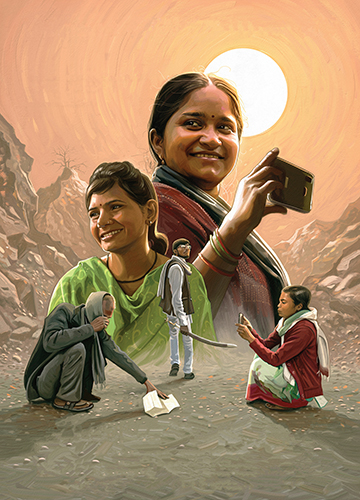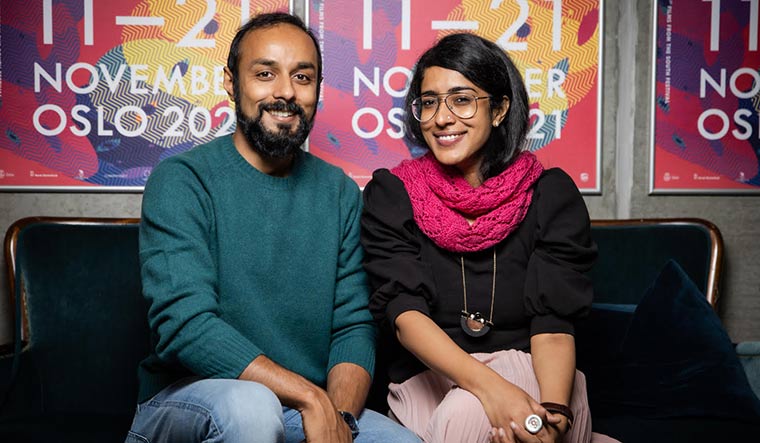Adalit woman journalist stands next to a television in a stark green office in Chitrakoot, Uttar Pradesh. Before her sit around 20 women, faces eager, nervous, staring into a future in which their place is uncertain. The woman journalist, Meera Devi, is the bureau chief of Khabar Lahariya, India’s only newspaper run by dalit women. This meeting of the women might be a historic one for the 20-year-old newspaper, as it marks the shift from print to digital.
“If we don’t adapt, we won’t survive,” says Meera.
The women look reverently at their new mobile phones. “I have never used a mobile phone,” says one of them. “I’m scared of damaging it.”
The montage is at the crux of Writing With Fire, the first Indian feature documentary to be nominated for the Oscars. Initially, its makers, Rintu Thomas and Sushmit Ghosh, were conflicted about the focus of the movie. They tried many permutations and combinations before realising that the arc of the film was going to be the journey of the newspaper from print to digital. “That is also the reason why the film is very consciously chronological,” says Rintu. “Because after every 10 minutes something shifts dramatically. We wanted to give this illusion of time passing as you watch these women working. Yet, it is also highly intersectional—it is a film about gender, media, populism and patriarchy. We went deep inside. We went into their intimate stories.”
The film was physically challenging—shot over four years in extremely dusty mining belts where temperatures are a constant 40 degrees, public transport is not easily available and you often have to travel with 12 people crammed into an auto-rickshaw. Because they had to walk an average of two to three hours every day with the journalists, the filmmakers shot the film hand-held, with no tripod; there would be only so much extra weight they could carry in their backpacks. “While we were battling with the physical aspects, the film’s themes were constantly playing out in our heads: the mechanics of the fourth estate, its true values, its independence, seeing things through a feminist lens, what citizenship and democracy can really mean,” says Sushmit. “Every time a scene would play out, we were like, how does this fit into the larger narrative of the film?”
For the filmmakers, the journey began in 2016, when they took a train to UP after seeing a photo story of a lone Khabar Lahariya journalist walking through an arid landscape with a newspaper in her hand. They kept the crew small, it was only Rintu (co-director and sound recordist), Sushmit (co-director and cinematographer) and Karan Thapliyal (cinematographer). The music was done by Tajdar Junaid and Ishaan Chhabra.
Writing With Fire primarily follows three women journalists—Meera Devi, Shyamkali Devi and Suneeta Prajapati—each of them with unique pasts that have defined their personalities. The challenge was in earning the women’s trust. “They chose us to tell their story,” says Rintu. “During the first shoot schedule, we just shadowed them, we were very silent. We developed a language where if some situation was risky—inside police stations or illegal mines—they would give us a cue as to whether we could shoot or not. Soon, they figured we were not there to disrupt their work.” The effort paid off. The film has won over 30 awards, including two at the Sundance Festival, besides getting a 100 per cent score on Rotten Tomatoes.
Interestingly, the filmmakers got married a year before the shoot for Writing With Fire started, “so the film has spanned the life of our marriage,” says Rintu with a laugh. The two met in film school in Jamia Millia Islamia in 2006, and worked together on their master’s thesis film, a short documentary called Flying Inside My Body, about how a gay and HIV positive photographer used his nude body to create photography that challenged notions of shame and acceptability. A year after graduating, they started their own film production company, Black Ticket Films. “We both come from very service oriented middle-class families, so this was a huge shift from everything I had imagined myself doing,” says Rintu. “We gave ourselves one year and said if Black Ticket Films does not do well in that time, we’ll disband it. We pooled our savings, registered the company, and for the first six to eight months, there was no work. We were too young in the eyes of people. They were like, ‘Your ideas are great, but where are your bosses?’ And that is when this hunger to create our own independent work began.”
Some of their well-known documentary shorts include Dilli, an 18-minute visual essay about Delhi during the Commonwealth Games, and Timbaktu which won a national award, about the shift of a small farming community in South India from its age-old practice of chemical agriculture to organic farming. “We have done a wide spectrum of films,” says Sushmit. “People ask us, are you interested in social justice stories, and we say, no, we are interested in deconstructing the world around us; that is the essence of our storytelling. So while the themes have been climate crisis, public health, women’s rights—these are intimate, human narratives first.”
The triumph of Writing With Fire is that it goes not just deep into the lives of the Khabar Lahariya women, but also into the recesses of their minds. The film is a searing portrayal of their fears, hopes and dreams. Their success, it seems to imply, is not despite their caste or gender. It is because of what these factors have made them. Now, they are finding a way to create an alternative structure of power which is not based on aggression or antagonising people whom they don’t agree with, but rather on being firm and thorough professionals. “While mainstream journalists would report a road accident as a breaking news, a Khabar Lahariya journalist would ask the hard questions,” says Rintu. “What was the budget sanctioned to construct that road? How much of it has been used in the fiscal year? Why does the road keep getting damaged? No one’s asking those questions.”
As the documentary goes places, literally and figuratively, so have the women. Meera was at the Sundance virtual premiere. She presented the film with Rintu and Sushmit for the International Documentary Film Festival Amsterdam. Khabar Lahariya collaborated with a German film festival for a three-day event on journalism. “Journalists from Berlin collaborated with those from the heart of Bundelkhand,” says Sushmit. “These are system-shifting conversations that are taking place.” After a lifetime of invisibility, these women are finally coming into the light.



